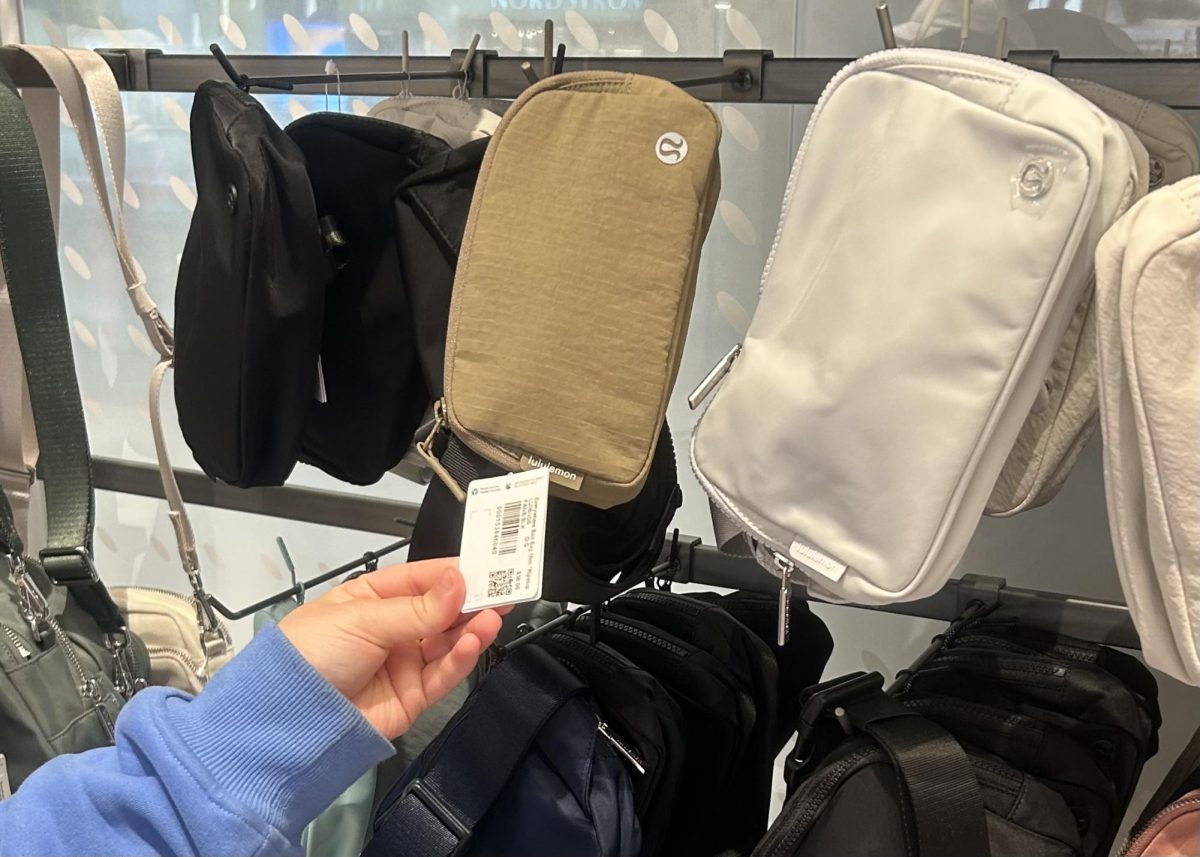Check your receipts, the rising prices of groceries and clothes are no accident. Behind every price increase are President Donald Trump’s new tariffs, policies that are rewriting the rules of international trade and impacting families across the nation.
Since before the presidential election, Trump has teased the idea of reciprocal tariffs that place the same tax rate on foreign countries as they do on the US. Now in office, Trump is turning his idea into action. After stepping into office in January, Trump quickly revealed tariff plans that would apply to some of the United States’ biggest trade partners — Canada, Mexico and China. Soon after, on April 2, dubbed by Trump as Liberation Day, sweeping tariffs were released on 185 countries.
The new tariffs were a part of a broader strategy to reduce the United States‚Äô trade deficit with other countries, which occurs when the United States imports more from a particular country than it exports.¬Ý
To Trump, trade deficits aren’t just numbers but signs of unfair treatment. He argues that other countries manipulate their currencies, subsidize industries and impose steep tariffs on U.S. goods to disadvantage American businesses. As a result, Trump believes that trade deficits lead to the loss of American jobs and the decline in domestic manufacturing, which contributes to an unequal playing field amongst businesses. These imbalances can lead to monopolization practices from foreign companies and damage the U.S. economy. For Trump, trade deficits and the dependence on foreign goods can be fixed through bold economic action.
However, the global backlash, economic volatility and rising consumer prices that followed have raised critical questions: do the tariffs truly help the U.S. economy? And is sacrificing years of global trade networks to protect the U.S. economy the right decision? Finally, what do Trump’s actions mean for students, the next generation of leaders?
Trump’s justification
Although Trump frames trade deficits as harmful, they are not necessarily bad. They can be a sign of a healthy economy. Trade deficits imply that citizens are wealthy enough to consume more than they produce. In other cases, trade deficits help the U.S. economy 一 specifically in the case of Canada. A significant part of the U.S.-Canada deficit comes from importing large amounts of crude oil, which ultimately helps to keep U.S. gas prices low, providing access to affordable energy resources.
‚ÄúA trade deficit [can be] deceiving,‚Äù social studies teacher Mel Trotier said. ‚ÄúIf you think of it like a business, you want to sell more than you buy, but you can’t necessarily think of a global economy or a nation’s economy in that kind of simplistic term. What we export is not necessarily a pair of shoes, but the idea behind the shoes or the technology that goes into a computer.‚Äù
Additionally, Trump has used misleading and often incorrect statements about tariffs and dynamics with other countries. Trump has overstated the size of trade deficits, claiming that the US trade deficit with Canada was 200 billion dollars when the actual figure was only 35.7 billion dollars. Likewise, Trump expressed that the U.S. had a trillion-dollar trade deficit with China when it was only 263.3 billion dollars.
Unfortunately, the exaggeration of numbers is a common political tool in today’s age that politicians use to influence voters. The lies of our politicians, from senators to representatives to the president, are told out of ambition for certain political agendas or election votes and have dangerous impacts on citizens.
False claims can lead to widespread confusion on critical issues — most notably, during the COVID pandemic, when misleading statements about vaccines and treatments jeopardized national security and safety. Beyond public health, misinformation can stir up anger and hate towards specific communities, driving people to act based on inaccurate beliefs. This not only undermines the integrity of our democracy but also creates a biased, polarized and less informed population.
‚ÄúDisinformation muddies the waters and makes it hard for people to make or have a clear opinion. There are a lot of politicians that are guilty of it, and they’re looking to drum up support and almost a sense of urgency in [their] voting base,‚Äù Trotier said.
April 2-5: Tariffs announced and implemented
While the intent behind Liberation Day was to free America, the aftermath came at the expense of both the U.S. and countries across the world.
After Liberation Day, several drastic tariffs were implemented, including a baseline 10% tariff on all imports, effective on April 5, as well as higher tariffs on 90 nations, official on April 9. No nation, ally, or adversary was exempt from these tariffs, with a 20% tariff on the European Union (EU) and even greater rates on Asian countries. Some of the highest tariffs were placed on Cambodia with a 49% tax rate and Vietnam with a 46% tax rate.¬Ý
‚ÄúIt was not a very thought-out decision, and members in Congress probably agreed, but they didn’t want to stand up to the president or the executive department. Overall, the country needs to become more cooperative and think through decisions about the power of the United States,‚Äù president of the youth and government club and junior Lily Overmann said.
The very act of calling such a day “Liberation Day” is problematic and manipulative. Around the world, liberation days carry deep historical significance. For instance, Italy, France, the Netherlands and Germany have their own liberation day observances tied to the end of Nazi rule. Likewise, liberation days across the world often mark the end of oppressive occupations, the fall of fascist regimes and the emancipation of enslaved people. These liberation days aren’t political labels — they represent the real sacrifices, efforts and progress of those who fought for justice. By using such an important term as a political strategy, Trump is undermining and disrespecting the gravity of those events.
The actions supposedly worthy of celebration on Liberation Day have been far from liberating. After his announcement, the repercussions of the tariffs were immediate, with the U.S. stock market plummeting. As a result, students and families are already facing the economic consequences as the price of goods rises. Supermarkets like Walmart plan to raise prices, while the Chinese-based online retailers Temu and Shein have raised prices in the past month.¬Ý
In response to the actions of companies globally, Trump posted on TruthSocial, “Between Walmart and China they should, as is said, ‘EAT THE TARIFFS,’ and not charge valued customers ANYTHING. I’ll be watching, and so will your customers.” Trump’s remark ignores the economic reality that when businesses face higher costs, as a result of tariffs, those costs inevitably reach consumers. Trump’s refusal to acknowledge this truth or collaborate with businesses to minimize costs shows a concerning disregard for the financial burdens placed on ordinary Americans.
April 8 – Current: Shifting tariffs
On April 8, tariffs on individual countries were officially implemented. However, 13 hours after the tariffs went into effect, Trump halted the tariffs, placing a 90-day hold on implementation. The pause was extended to all countries except China. Thereafter, the U.S. stock market soared once again, with the S&P 500 rising 9.5% ‚Äî the highest single-day rise since October 2008.¬Ý
But this sudden reversal sent shockwaves through global markets and diplomatic networks. Trump‚Äôs unpredictable on-and-off tariffs have created an atmosphere of uncertainty, leaving businesses unable to plan and allies reluctant to trust the United States. As the elected president, Trump has the responsibility to the American people to act with transparency and reliability. Tariffs are not meant to be created on impulse ‚Äî they affect entire economies and countless lives.¬Ý
To make matters worse, Trump’s pause is not permanent. On May 16, Trump announced that he would soon set new tariff rates for 150 countries if they do not strike new trade agreements with the U.S., focused on renegotiating tariff terms before the end of the 90-day pause. While Trump officials claim that around 100 countries are willing to negotiate deals, the reality is that trade agreements are highly complex and delicate. Striking dozens of new deals within three months is nearly impossible.
Trump‚Äôs unrealistic demands have already damaged relationships with many of the U.S.‚Äôs strongest allies, igniting global tensions. Before the tariffs were paused, nations, like those in the EU, had already approved and planned to impose similar tariffs on the US.¬Ý
In all the chaos, the greatest victim by far is the United States‚Äô relationship with China. Trump‚Äôs tariffs have created a trade war, which occurs when two countries try to damage each other‚Äôs trade through tariffs or quota restrictions. On Liberation Day, Trump initially placed a 34% tariff on China and the Chinese government quickly responded with a reciprocal 34% tariff on all US goods. Things quickly escalated on April 9, as Trump raised tariffs to 104%, prompting China to immediately increase their tariffs to 84%. Trump countered with a 145% tariff on the same day. Three days later, China announced a 125% tariff on US goods.¬Ý
‚Äú[The tariffs are] making cooperation more difficult and worsening our relationships with adversaries like China. Having a trade war with China isn’t going to help anyone. The truth is that we do get a lot from them, so it’s not a good idea. Also, we’re increasing tensions with the European Union, which has been our ally, [will] lead to less cooperation,‚Äù Overmann said.
As of May 12, the United States and China have finally agreed to a 90-day pause on most retaliatory tariffs. But, the pause is not permanent and the future holds considerable uncertainty for the world, businesses, families and students alike.
Future
As Trump continues to rally with his tariffs, he is also sending a message to the young students across the country. His ‚ÄúAmerica First‚Äù campaign and protectionist stance ‚Äî that trade agreements should prioritize U.S. interests above all else ‚Äî inadvertently teaches young students to reject the value of global cooperation. Trump‚Äôs retaliatory measures fuel a cycle of retaliation rather than fostering collaboration.¬Ý
Recognizing the necessity of global cooperation is crucial to ensure that the next generation truly understands the complexities of our world. Yet, the current political landscape instills biases and creates a fear of cooperation. Schools can guide students through the political atmosphere by fostering critical thinking and nuanced discussions about global issues.
‚ÄúA lot of times, schools avoid the topic of politics because of how polarized our political climate is,‚Äù Overmann said. ‚ÄúBut [if] schools can talk more about different political issues without [expressing] opinions, people would know more [about] the issues, like what a tariff really means. [Schools] could do more to describe current political issues, because we talk a lot about the history of it, but [schools] could do a better job of connecting it to the present.‚Äù¬Ý
Our students are leaders of tomorrow. If they are taught to fear collaboration and understanding, the consequences will ripple far beyond the classroom, shaping a future marked by division and conflict.
‚ÄúThere’s too much [global] interconnectedness to withdraw from,‚Äù Trotier said. ‚ÄúThe future [means] working on the connections [rather] than pulling back from them.‚Äù

![Shifting global trade, President Donald Trump’s tariffs are raising concerns about economic stability for the U.S. and other countries alike. “[The tariffs are] going to pose a distinct challenge to the U.S. economy and a challenge to the global economy on the whole because it's going to greatly upset who trades with who and where resources and products are going to come from,” social studies teacher Melvin Trotier said.](https://pwestpathfinder.com/wp-content/uploads/2025/05/MDB_3456-1200x800.jpg)

![Sitting courtside before a junior varsity girls’ tennis match, senior Tanisi Saha rushes to finish her homework. Saha has found herself doing academic work during her athletic activities since her freshman year. “Being in sports has taught me how to stay organized and on top of my schoolwork. [With] a busy practice and game schedule, I’ve learned to manage my homework and study time better,” Saha said.](https://pwestpathfinder.com/wp-content/uploads/2025/11/DSC_0022-1200x800.jpg)
![Sophomore Maryem Hidic signs up for an academic lab through Infinite Campus, a grading and scheduling software. Some students enjoyed selecting their responsive schedule in a method that was used school-wide last year. “I think it's more inconvenient now, because I can't change [my classes] the day of, if I have a big test coming and I forget about it, I can't change [my class],” sophomore Alisha Singh said.](https://pwestpathfinder.com/wp-content/uploads/2025/10/DSC_0012-1200x801.jpg)
![Senior Dhiya Prasanna examines a bottle of Tylenol. Prasanna has observed data in science labs and in real life. “[I] advise the public not to just look or search for information that supports your argument, but search for information that doesn't support it,” Prasanna said.](https://pwestpathfinder.com/wp-content/uploads/2025/10/DSC_0073-2-1200x800.jpg)
![Junior Fiona Dye lifts weights in Strength and Conditioning. Now that the Trump administration has instituted policies such as AI deregulation, tariffs and university funding freezes, women may have to work twice as hard to get half as far. "[Trump] wants America to be more divided; he wants to inspire hatred in people,” feminist club member and junior Clara Lazarini said.](https://pwestpathfinder.com/wp-content/uploads/2025/05/Flag.png)
![As the Trump administration cracks down on immigration, it scapegoats many immigrants for the United States’ plights, precipitating a possible genocide. Sophomore Annabella Whiteley moved from the United Kingdom when she was eight. “It’s pretty scary because I’m on a visa. When my visa expires next year, I’m not sure what’s going to happen, especially with [immigration] policies up in the air, so it is a concern for my family,” Whiteley said.](https://pwestpathfinder.com/wp-content/uploads/2025/05/DSC_0077-7copy.jpg)



![Some of the most deadly instances of gun violence have occurred in schools, communities and other ‘safe spaces’ for students. These uncontrolled settings give way to the need for gun regulation, including background and mental health checks. “Gun control comes about with more laws, but there are a lot of guns out there that people could obtain illegally. What is a solution that would get the illegal guns off the street? We have yet to find [one],” social studies teacher Nancy Sachtlaben said.](https://pwestpathfinder.com/wp-content/uploads/2025/01/DSC_5122-1200x800.jpg)


![Sophomore Shree Sikkal Kumar serves the ball across the court in a match against Lindbergh. Sikkal Kumar has been a varsity member of the varsity girls’ tennis team for two years, helping her earn the number two rank in Class 2 District 2.“When matches are close, it’s easy to get nervous, but I [ground] myself by[staying] confident and ready to play,” Sikkal Kumar said.](https://pwestpathfinder.com/wp-content/uploads/2025/11/DSC2801-1200x798.jpg)
![Dressed up as the varsity girls’ tennis coach Katelyn Arenos, senior Kate Johnson and junior Mireya David hand out candy at West High’s annual trunk or treat event. This year, the trunk or treat was moved inside as a result of adverse weather. “As a senior, I care less about Halloween now. Teachers will bring their kids and families [to West’s Trunk or Treat], but there were fewer [this year] because they just thought it was canceled [due to the] rain. [With] Halloween, I think you care less the older you get,” Johnson said.](https://pwestpathfinder.com/wp-content/uploads/2025/10/DSC00892-1-1200x800.jpg)
![Focused on providing exceptional service, sophomore Darsh Mahapatra carefully cleans the door of a customer’s car. Mahapatra has always believed his customers deserve nothing less than the best. “[If] they’re trusting us with their car and our service, then I am convinced that they deserve our 100 percent effort and beyond,” Mahapatra said.](https://pwestpathfinder.com/wp-content/uploads/2025/10/DSC_0018-1200x800.jpg)
![Sophomore Aleix Pi de Cabanyes Navarro (left) finishes up a soccer game while junior Ava Muench (right) warms up for cross country practice. The two came to Parkway West High School as exchange students for the 2025-2026 school year. “The goal for the [exchange] program is to provide opportunities for both Parkway students and our international exchange students to learn about other cultures, build connections and become confident, capable, curious and caring — Parkway’s Four C’s — in the process,” Exchange Program Lead Lauren Farrelly said.](https://pwestpathfinder.com/wp-content/uploads/2025/10/Feature-Photo-1200x800.png)
![Leaning on the podium, superintendent Melissa Schneider speaks to Parkway journalism students during a press conference. Schneider joined Parkway in July after working in the Thompson School District in Colorado. “My plan [to bond with students] is to get things on my calendar as much as possible. For example, being in [classes] is very special to me. I am trying to be opportunistic [meeting] kids [and] being in [the school] buildings. I have all the sports schedules and the fine arts schedules on my calendar, so that when I'm available, I can get to them,” Schneider said.](https://pwestpathfinder.com/wp-content/uploads/2025/09/IMG_5425-1200x943.jpeg)
![Gazing across the stage, sophomore Alexis Monteleone performs in the school theater. The Monteleone family’s band “Monte and the Machine” has been releasing music since 2012, but Alexis started her own solo career in 2024 with the release of her first single, Crying Skies. “My whole family is very musical, [and I especially] love writing [songs with them],” Monteleone said.](https://pwestpathfinder.com/wp-content/uploads/2025/09/DSC7463-1200x798.jpg)

![Leaping through the air, senior Tyler Watts celebrates his first goal of the season, which put the Longhorns up 1-0 against the Lafayette Lancers. Watts decided to play soccer for West for his last year of high school and secured a spot on the varsity roster. “[Playing soccer for West] is something I had always dreamed of, but hadn’t really had a good opportunity to do until now. It’s [really] fun being out [on the field], and I’m glad I decided to join the team. It’s just all about having fun with the boys and enjoying what time we have left together,” Watts said.](https://pwestpathfinder.com/wp-content/uploads/2025/09/DSC_1951-1200x855.jpg)

![Helping a customer, print room assistant Gretchen Williams operates her booth at the West High Craft Fair from Oct. 25-26. This was Williams’ first time participating in the Craft Fair with her new craft shop, Gs Beaded Boutique. “People have always said, over the years, ‘you should open something.’ [I replied that] I would rather just make [my crafts as] gifts for people. I just started [the online store] up, and it's been okay. I'm always surprised [by] how many views I get and [the] people from different states buying things; somebody from Alaska bought something the other day.”](https://pwestpathfinder.com/wp-content/uploads/2025/11/DSC0451-2-1200x799.jpg)
![Between lights, smoke and a captive audience of students, science teacher Joel Anderson conducts his annual Halloween show in class on Oct. 31. Anderson has performed the Halloween show every year for 27 years, since he started teaching in 1999. “[My favorite part about the show] is getting students excited about it and seeing their level of anticipation. After the students see it, they realize that [I] put a lot of time and effort into it,” Anderson said. “They also end up learning because I sneak some chemistry into the [show] as well. So, it’s a whole bunch wrapped up in a 15 or 20-minute package. It’s really scary.”](https://pwestpathfinder.com/wp-content/uploads/2025/11/DSC_9047-Enhanced-NR-1200x798.jpg)


![Smiling in a sea of Longhorns, Fox 2 reporter Ty Hawkins joins junior Darren Young during the morning Oct. 3 pep rally. The last time West was featured in this segment was 2011. “[I hope people see this and think] if you come to [Parkway] West, you will have the time of your life because there are so many fun activities to do that make it feel like you belong here. I was surprised so many people attended, but it was a lot of fun,” Young said.](https://pwestpathfinder.com/wp-content/uploads/2025/10/Edited2-1200x798.jpg)

![Blue lights shining brightly, senior Riley Creely beatboxes into the microphone. Creely and the group began the performance in front of the blue lights, sparking interest from the audience. “The pep rally performance was fun. I got to beatbox for the first half of the song, which was hype. I liked to look into the student section [while I performed],” Creely said.](https://pwestpathfinder.com/wp-content/uploads/2025/09/DSC_5085-Enhanced-NR-1200x799.jpg)
![Hugging senior Ella Wheeler, senior Jamaya Love beams after scoring a touchdown at the Powderpuff football game on Sept. 11, putting the seniors on the scoreboard with a score of 6-2 above the juniors. The seniors went on to capture the victory with a final score of 12-2. “I was actually gassed [at this moment]. I was so tired. But, everyone on the sideline, all my teammates and everybody in the stands were cheering,” Love said.](https://pwestpathfinder.com/wp-content/uploads/2025/09/DSC1735-Enhanced-NR-2-1200x799.jpg)
![Raising her hands in the air, freshman Jillian Sternhagen follows Mr. Mooney’s lead during an activity Aug. 15 at freshman orientation. Surrounded by other freshmen, Sternhagen learned an “A O E day” chant to help remember their new weekly high school schedule. Students participated in several activities to get to know each other, the school and the upperclassmen. “We got to tour the school and learn where everything in our schedule is. The energy [at orientation] was fun; the leaders were peppy and got us excited,” Sternhagen said.](https://pwestpathfinder.com/wp-content/uploads/2025/08/DSC_0145-1200x798.jpg)


Maria Rademeyer • May 30, 2025 at 8:56 am
Excellent story, Yein!
Ryan Shabani • May 28, 2025 at 12:23 pm
This is amazing Yein!
Alisha • May 28, 2025 at 7:39 am
Another week, another eat by Yein üòçüòç